#HEMA fencer
Explore tagged Tumblr posts
Text

Pride is over
So begins WRATH
Also this sword was so good to fence with, SO much nicer than the economy castille
#hema#hema fencer#girls with swords#rapier#trans woman#transgender#queer#lesbian#beathewitch#bea pics
53 notes
·
View notes
Text

YOU KNOW WHAT DAY IT IS IT'S FUCK IN ARMOUR FRIDAY AGAIN 🔥🔥🔥
#i cast new kink upon thee#this wont be the last one i do. this is a warning#knight x fencer#????LMAO#knightposting#knight#knights#armor#knightcore#artists on tumblr#knight kink#hema#hema gear#hema fencer#knight nsft
275 notes
·
View notes
Text
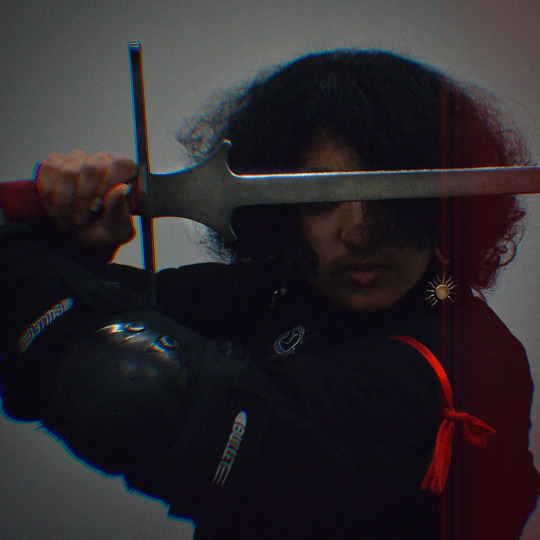
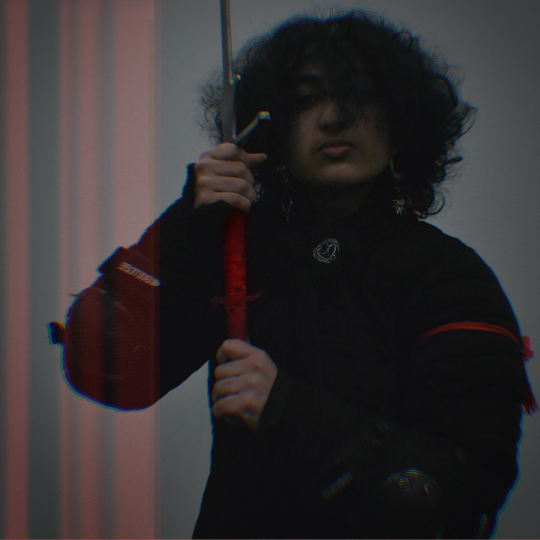

(There’s been some confusion, I’m a real fencer, not a cosplayer 😭😭)
My friend and I took some amazing and edgy glamour shots of me in steel fencing kit holding a steel sword yesterday, I’ve just been playing about with them.
The red band around my arm would signify who I am in the tournament (You’re either Red Fencer or Blue Fencer, they don’t call out your name during a fight), and well, my best friend’s steel jacket is already blue so that makes me Red Fencer. And fits with my Jupiter persona—
They’re very album-image-esque. Me, getting into music? No wayyyyyyhhhhh unlesss (I don’t just foreshadow nothing!) (Don’t worry I have a musical background + bits of musical theatre too, I promise I’m not a YouTuber who just decides they’re a singer 😭😭😭) For fun, anyway.
Side note: Not all the guards I did in those shots are real fencing guards, sometimes we just wanted a good shot.
Credit for for original shots: @ashrimpyshrimp
#elmushterri#red fencer#hema fencer#hema#wma#fencer#fencing#historical European martial arts#steel sword#longsword#women with swords#women in fencing#swordswoman#swords#knight#photography#art
475 notes
·
View notes
Text

I got really hot during training, sorry. I had to air out a little.
... My mask? No, I'm not removing it.
92 notes
·
View notes
Text
I grabbed his sword and stepped forward to pin him, but trapped my sword in the undertaking of such a maneuver. While I wrestled with the two interlocked blades, trying to free mine without allowing him a strike, my opponent tapped his helmet to mine and whispered "Mwah!"
56 notes
·
View notes
Text
cracking up bc every time I open my texts I see "I'm here to get knees!" devoid of any other context
#the context is i picked up a pair of extra knee protectors from another fencer for my frankenstein steel gear kit#but jshdhdjkd#hema log
3 notes
·
View notes
Text
New Longsword Drill Alert!!!!
Are you a short fencer? Do you resign yourself to hand snipes and then deal with tall fencers calling hand snipes “historically inaccurate and bad fencing”? (First of all, cope <3 why are your hands out in hitting distance? Apparently Queen’s gambit is doing height classes because the tall fencers were upset against short people clowning their hands)
Anyways-
I was sparring under Meyer rules where only headshots are scoring actions. I found that I had to remember to retreat and that sometimes taller fencers also forget to protect their heads.
I had the most success with hanging guards >:)
7 notes
·
View notes
Text
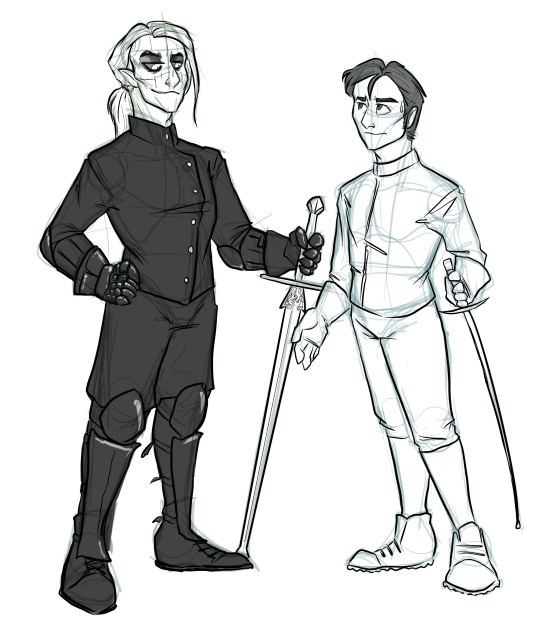
what if i was an olympic sport fencer and you were a HEMA longsword fencer...and you kept menacing me with your over-6-foot frame and enormous steel weapon...and we were both boys
#gthis is stupid but i couldnt rest until i drew it#outfits are approximate i didnt feel like consulting many refs. nuada should have upper arm guards on too but iiii had already lined it#realistically he should be a spear fencer but longsword feels a little more ubiquitous for hema. at least in my mind#hellboy#prince nuada#john t myers#hellboy the golden army#jn
29 notes
·
View notes
Text
I want to empathize as a fellow transfem but I REALLY hate Olympic fencing and that overrides everything else. Olympic fencers deserve discrimination I think.

14K notes
·
View notes
Text
Modern AU Idea Free to a Good Home Because the other time period type au I Already Have is Killing Me
Renly and Loras live in the ancestral pile Storm's End Manor etc need some decorative as well as functional iron work repaired or restored up to historical preservation standards there's short list of tradesfolk qualified and skilled enough to do it properly. Gendry happens to be on that list and comes highly recommended because was trained by Tobho Mott who was The Best but has been retired for a while. They have never met before nor does he have social media accounts with pictures of himself. So he shows up to the Manor in his tradie van knocks on the door and it's "Surprise you have another nephew but this one is distressingly older than the other ones and younger than Mya obviously teenage Robert didn't know how to wrap it up at all."
Direction 1 Loras is the one to answer the door, Renly is out on an errand or something that took longer than expected. Having the excuse to corral their escape artist dog he calls/texts Renly to tell him he has another nephew and somehow he's bigger and brawnier than Robert ever was in his prime Direction 2 Renly opens the door looks up (a rare occasion for him) and has moment of "hey this is what it was like to be kid" before the "oh no Robert why sex is just as good wrapped as it is raw you drunken ass now I'm looking at young man who's very confused as to why I look like him" occurs which he doesn't feel equipped to handle but he'll do his best. Direction 3 chaos Gendry is faceblind and aware these new clients are having emotions about something but unaware those two things are connected. A comedy of errors to get to the damn point, maybe Stannis shows up and puts everyone out of their misery by being his blunt straightforward self. He'll like or at least respect Gendry I think.
#meet the (bio)family you never knew you had#I think Arya in this could be a champ fencer who quit the circuit to do HEMA instead#Gendry#renly x loras
0 notes
Text
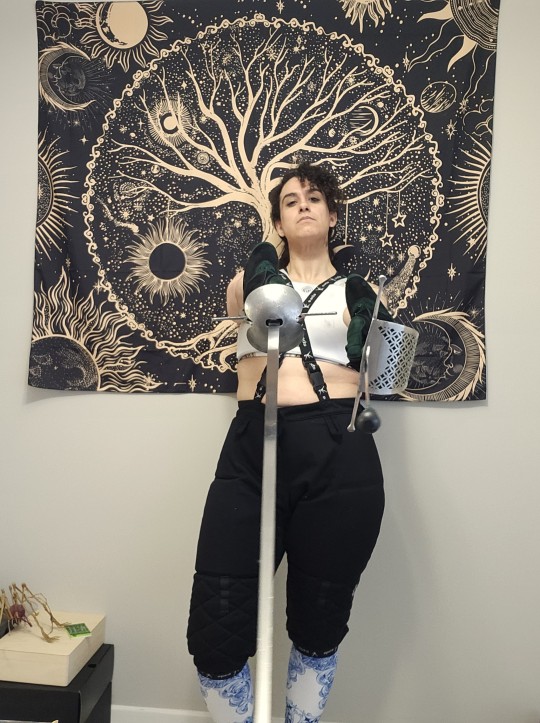



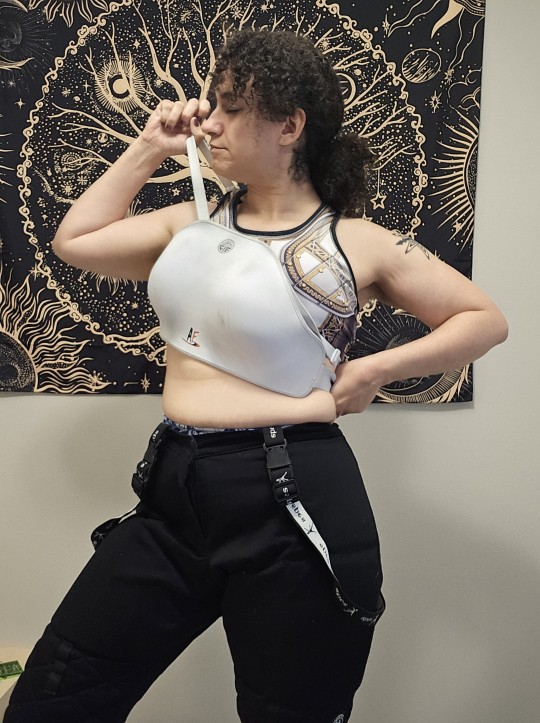

Sword girl doing sword girl things
#trans gamer#trans woman#transgender#lgbtqia#queer#trans joy#trans is sexy#trans beauty#trans femme#trans hema#hema#woman fencer#women who fence#trans women rule#trans women are beautiful#hema fencer#beathewitch#trans#trans is beautiful#bea pics
120 notes
·
View notes
Text

iT'S!!! FUCK IN ARMOUR FRIDAY!!!!! YET AGAIN!!!!!
#knightposting#knight#knightcore#knights#armor#medieval knight#knight kink#fencer#fencing#fencing kink#hema kink#knight x fencer#knight nsft#hema nsft
143 notes
·
View notes
Text
Ohhh cosmos it’s happening. Also this is the cam’s audio not the microphone audio dw.
Featuring Lysithea, my friend’s sword (he named it after a moon of Jupiter 🧡✨)
123 notes
·
View notes
Text
So I fought the single rapier world number 112 at a tournament a few weeks ago, and other than being a lovely human being who beat me thoroughly like 11-5, I did get this nice attack which I feel warrants some more analysis.
I was essentially trying to recreate a method of attack that I've seen some Olympic epee fencers do a few times, wherein they quickly duck beneath their opponent's point to score. Like so:
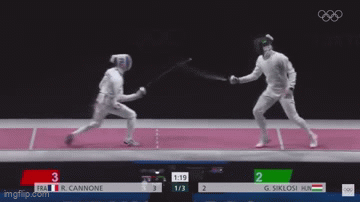
The problem is though, this is often contingent on your opponent going for an attack of their own - and my opponent unfortunately does not take the bait. Rather, he retreats and moves out of distance, preventing me from scoring in the traditional epeeist way.
However! While the original plan failed, it did present an opportunity for a fun play. As I crouched suddenly and agressively while moving forward, my opponent, having some self preservation, retreats a little. While he does this, he drops his guard slightly, moving from seconde (defending the outside line with wrist pronated) to quarte (defending the inside line, wrist supinated) This, naturally, exposes his outside line.
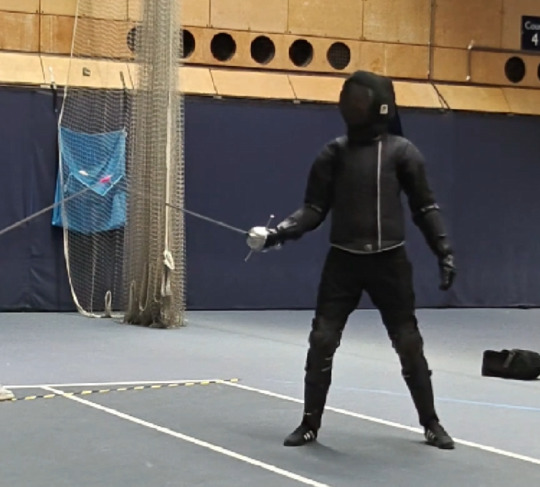
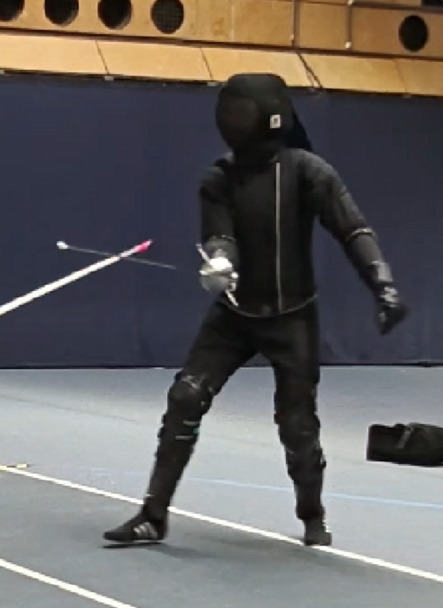
In that moment, I was able to extend my point, pronate my wrist, and launch a fleche (an attack where the back leg passes over the front, creating an explosive running attack) which lands cleanly onto his chest/shoulder area.
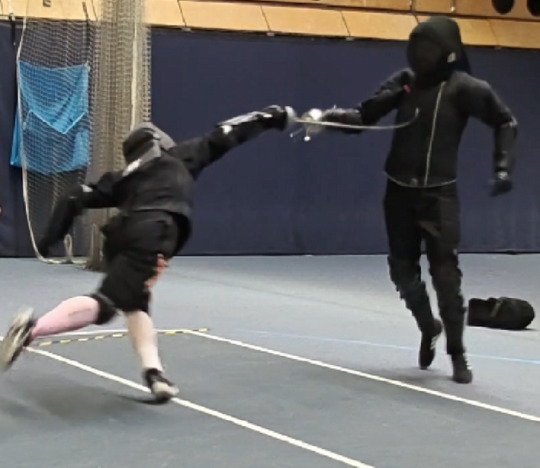
The benefit of pronating my wrist is it creates opposition. While Olympic epee is governed by electric score boxes which have built in delays to officiate afterblows (In epee, once a light goes off, the other fencer has only 40 milliseconds to land their afterblow), HEMA is a lot more based on the judges discretion. Thus, it is much more important to make it clear that any afterblow is parried or significantly out of time.
By pronating my wrist, and placing my blade on my outside line so that my long edge faces his blade, I was able to both attack and move his blade clear as I did. In doing so, I pretty much pre-parry any counter he has at his disposal. While his blade does get out at the end and potentially clip my leg a teeny bit, this is easily over an acceptable tempo where an afterblow can be given, and therefore, the three points for a thrust to a chest was awarded to me!
To be honest though, a lot of this analysis is fun to do after the fact, but my body moved before my brain could process what it was seeing properly, so I'm thanking the training and muscle memory for this.
Anyway I'm still not really sure what I'm posting on this damn website so like if anyone has bothered to read all of this, and liked it, please let me know and I'll keep at it!
#rapier#fencing#swords#sword#hema#tournament#strategy#tactics#analysis#dagger#history#europe#european martial arts#historical fencing#historical martial arts
39 notes
·
View notes
Text
For the yet-to-be-informed, let me preach to you the gospel of Das gayszlen

What is Das Gayszlen?
Das gayszlen, generally translated as the "whip" is a technique in historical longsword fighting from 15th century German tradition. The basic mechanics of the gayszlen are as such: a single handed strike with the nondominant or lower hand, where the sword is released from a traditional grip to allow the blade to sweep towards the leg of your opponent. Some also define other one handed strikes, slices, or thrusts as a gayszlen, but (in my experience) the more common interpretation is the narrower definition I provided. There is some difficulty however in knowing definitively how it was used historically, beyond the general difficulty in knowing anything for certain in HEMA that comes with the territory of reviving a dead art. Much proverbial ink has been spilled online about how, when, and if it is appropriate to use, and many consider it to be a cheap trick, not to be used in serious competition or incorporated into a revival of historical fencing systems. I have Thoughts™ about it and my new URL change inspired me to detail those thoughts, continued below.
Where does it come from?
Ok. so. maybe "15th century german tradition" is a bit generous. There is a grand total of ONE source for the gayszlen, which is in a fechtbuch (fencing book) by fencing master and author Hans Talhoffer, one of the most influential and prolific of his time. His numerous manuals cover a wide range of weapons and techniques including grappling, dagger, polearms, mounted and armoured combat, as well as some more silly things like duelling/long shields and "man vs woman" duels (last two pictured below).
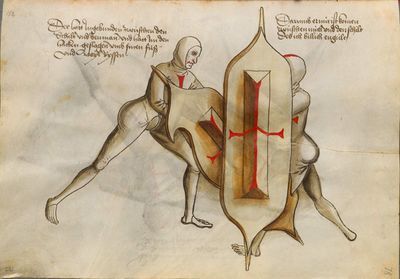

Despite all that and multiple depictions of many of the techniques for these silly "niche" styles of combat (at least in the context of modern HEMA practice, they likely were somewhat prevalent at the time and used to resolve legal disputes) there is only one illustration of the gayszlen, in one of Talhoffer's books. It depicts an exchange between a fencer in a "free point" (afaik the only time that term is used as well, though it is a position that is quite common in german longsword fencing, being a sort of hanging guard or the midpoint of a strike like a zwerchhau) and another performing the gayszlen against the aforementioned fencer, shown below (figure on the right is performing the gayszlen).

You may notice the text on the image, next to each figure! These say Ain fryes ortt and Das gayszlen, again translated as "a free point" and "the gayszlen". You may ask "but what does the actual caption or description say about it?!" I'm so sorry to disappoint you, and I share in your misery: this is all there is. Truly sad, I know. This lack of source material is (in my opinion) why there is so much difficulty defining it and so much debate over its historical usage and value in modern use.
So how do people interpret it?
As stated earlier, the (general) consensus is that it is a one handed strike (a hit, hew, or cut, as opposed to a thrust or draw/push slice) made with the offhand to the lower half of the opponent's body. One of the main disagreements on how to interpret this is whether the sword is "whipping" or cutting to the left from the right, or from the right to the left. Based on the foot position, it might look like the fencer performing the gayszlen (hereafter referred to as G) is bringing the sword from their left side to swing into the opponent's (hereafter referred to as F) left calf. However, this hand position and movement of the sword leaves G entirely open to attack anywhere on their torso or the right side of their body generally. An example of me (right) executing this interpretation is below: you can see that I do actually get the hit, but my opponent nearly hits me with the first strike to the right side of my head, where I am most vulnerable, and follows it up with another strike to my head. If this scenario played out with sharp swords and no protective gear I would lose this fight.
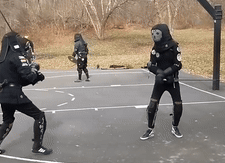
Another interpretation of the gayszlen is this: G holds the sword in any guard on the right side of their body (higher guards may be better for generating more force or deciding to do literally anything other than the gayszlen) and releases the sword from their right hand, holding the pommel in the left and sweeping the sword towards F's right calf. in the picture we have, it may be that the "free point" is meant to be a response to the gayszlen, and therefore F is retracting their foot to avoid the gayszlen, while striking G to their unprotected body. An example of me (left) attempting to execute this interpretation is below: even though my opponent fails to parry or suppress my attack, it wasn't necessary. I didn't have the reach to hit her leg, though her dodge may have saved her even if I had been a bit closer to begin or had extended farther.
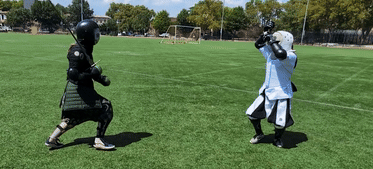
Something that I believe supports this second interpretation is the general attitude of historical German longsword manuals to favor attacks and guards from above, to high openings, or generally closer to the upper half of the body than lower attacks and guards. A reason for this is detailed in many European sword systems, namely the destreza rapier tradition, thibault by extension, and meyer.

https://www.youtube.com/shorts/tPHbG28niyc
The above image and video are pretty simple explanations, the core idea being that a sword and arm extended at the height of the shoulder (or nearer the shoulder) will have more forward reach than a sword and arm extended higher or lower than the shoulder. Because of this, F theoretically has somewhat of a reach advantage over G, as their sword and arm are closer to their shoulder. though the utility (as I'll talk about more later) of the gayszlen is that it is done in a grip that extends G's reach beyond a normal grip like F has.
There are also interpretations that point to it being a thrust (like I attempt below) which is supported by similar techniques showing up in other European sword systems, which I could spend a whole equally long post talking about, but this is plenty long as is, maybe a topic for another time. The two lame reasons I have for not liking this interpretation is that a thrust doesn't seem very "whiplike", and also a thrust to the legs with one hand is harder to pull off than a cut to the legs or a one handed thrust to the torso.
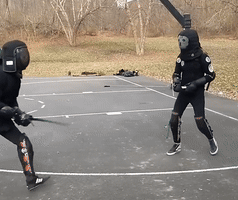
How can I incorporate the gayszlen into my modern HEMA practice?
To preface this, throughout all of this I'm mixing terms and concepts from Fiore and Liectenauer and Talhoffer and Meyer and probably some other stuff. I primarily study and practice Liechtenauer blossfechten via Ringeck, Danzig, and Lew, as well as most of Fiore's system. This is just my opinion on what purpose the gayszlen can serve in the frog DNA filled world of HEMA longsword, this is not pure to any martial art system, just an application for the sport.
That being said: I believe the gayszlen's place in modern longsword fencing is similar to that of guards like the boar's tooth, long tail, or the key, all of which can use distance deceptively. they place the sword further back than it would be in an iron gate or a plow (guards which are somewhat close to those I mentioned) and allow the fencer using them to seem less threatening than they would with more aggressive guards. Likewise, I often find myself throwing gayszlens from positions where I'm somewhat retracted or seemingly out of distance, or preparing for an attack to another opening. This can often allow an attack at an unexpected timing or from an unexpected angle. I find it works well when your opponent is static in a guard and you to a distance juuust outside of where you could hit them with a normal grip, and the switch to a one handed pommel grip gives you the couple inches you need to get the hit, and hopefully enough speed to avoid getting beaten away by their sword. One of the big dangers with the gayszlen is the opportunity it presents for getting hit. When you employ this technique, you give up basically all protection your sword has to offer, you can't block any incoming attacks, and you don't have a good enough grip to bat your opponent's sword out of the way. This means that if you don't plan well, you leave yourself totally open to a double or a hit to you if they avoid your gayszlen. See below! The fencer attempting the gayszlen (right) goes in with his head down and totally unprotected, allowing the opposing fencer to get a really beautiful hit to his head as she dodges his gayszlen. This is what you should do if you encounter someone who is eager to use the gayszlen and you wish to discourage them.

A safer position (both to avoid getting hit and to avoid injury, as I'll mention in the next section) is a more upright stance and a deep lunge, though keeping your shoulder up, as I mentioned earlier, reduces your range to that lower point.
Why don't some people allow it in tournaments?
Many tournaments, in my area and others, don't allow gayszlens. some ways this manifests are bans on all one-handed cuts, all one handed strikes altogether, including thrusts, hits to the leg below the knee, etc. Some people just don't like the gayszlen, think it's too hard to judge, think it doesn't have enough historical basis, or think it is dangerous to the person doing it or the person having it done to them. A lot of those reasons are laid out in this article, which, while I disagree with most of the points, makes those points pretty well. It's also the first result when you search on google for gayszlen, which makes me sad :( Another argument regarding the safety that isn't mentioned in that article is that to get additional reach and evade strikes from above, some people get really low when executing a gayszlen, even exposing the back of their head or body, which can lead to some really nasty hits to the back of your head or your spine, which are vulnerable areas even when wearing gear, are are often the parts of the body that have the least protective gear. In my opinion, any ruling that is intended to ban gayszlens that we've seen is too broad. banning one-handed cuts (or strikes altogether) means that whole sections of manuscripts or traditions (such as fiore's uno mano plays) can't be performed, banning cuts to the legs or parts of the legs can give an advantage to taller fencers, discarding them automatically because they're too difficult to judge the quality of can punish those who have worked to perfect them safely, etc. At the end of the day it doesn't really make a huge difference one way or the other, and every tournament organizer is biased in the way they make their ruleset one way or the other, but I think the gayszlen is unfairly maligned. In my opinion, with proper attention to levels of force, protective equipment, and judging, the gayszlen deserves a place in modern HEMA tournaments.
ALSO IT HAS GAY IN IT TEEEHEE!!
some people pronounce it "guy-slen" and I usually say "gay-slen" and I don't speak modern or medieval german so idk how it should be pronounced but I like saying gay :) because homosexuality get it???? I
I've made the gayszlen a bit of a meme in my local scene by shouting "GAYSZLEN" whenever I do it, like an anime character. This is typically regarded with friendly annoyance, and it makes hitting this silly ass technique SO much more satisfying and makes whiffing it a lot less embarrassing :)
anyways thanks for reading my long ass post ily <3 if anyone has additional thoughts, please leave them in the comments! I'd rather not debate anything, but I'd be happy to discuss intricacies of the gayszlen's use and interpretation if you're nice about it!
123 notes
·
View notes
Text
Every now and then the Discourse flares up around certain characters: they are a fighter, they cannot look Like That! They are too strong, they must be This One body type and saying otherwise makes you stupid!!!
Guys.
I did HEMA fencing for six years. And let me tell you - our top fighters? Both men and women? They came in all shapes and sizes.
Some were absolute shit brickwalls. Some were made of bones, scrawny muscle and not much else. Of course they all favoured different techniques (strength and stamina vs speed and agility) but they were all fencers and all phenomenal at it.
Your fighter character can be shaped like a barrell or a stick, it doesn't matter, there's most likely a real life martial artist out there who looks like that.
73 notes
·
View notes